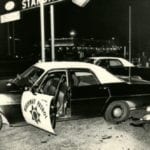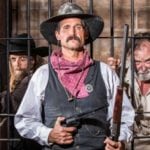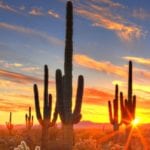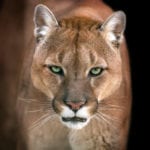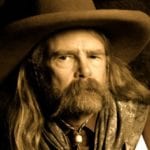 Mysteries
Mysteries  Mysteries
Mysteries  History
History 10 Surprising Stories About the Texas Rangers
 Humans
Humans 10 Philosophers Who Were Driven Mad by Their Own Theories
 Miscellaneous
Miscellaneous 10 Video-Game-Worthy Weapons and Armors from History
 Weird Stuff
Weird Stuff 10 Psychics Who Accurately Predicted Wartime Events
 The Arts
The Arts 10 Pieces of Art Inspired by a Broken Heart
 Health
Health 10 Science Fiction-Sounding New Medical Treatments
 History
History 10 Surprising Facts About the Father of Submarine Warfare
 Space
Space Ten Astonishing New Insights into Alien Worlds
 Weird Stuff
Weird Stuff 10 Bizarre Summer Solstice Rituals Still Practiced Today
 Mysteries
Mysteries Top 10 Haunting Facts About the Ghost Ship MV Alta
 History
History 10 Surprising Stories About the Texas Rangers
 Humans
Humans 10 Philosophers Who Were Driven Mad by Their Own Theories
Who's Behind Listverse?

Jamie Frater
Head Editor
Jamie founded Listverse due to an insatiable desire to share fascinating, obscure, and bizarre facts. He has been a guest speaker on numerous national radio and television stations and is a five time published author.
More About Us Miscellaneous
Miscellaneous 10 Video-Game-Worthy Weapons and Armors from History
 Weird Stuff
Weird Stuff 10 Psychics Who Accurately Predicted Wartime Events
 The Arts
The Arts 10 Pieces of Art Inspired by a Broken Heart
 Health
Health 10 Science Fiction-Sounding New Medical Treatments
 History
History 10 Surprising Facts About the Father of Submarine Warfare
 Space
Space Ten Astonishing New Insights into Alien Worlds
 Weird Stuff
Weird Stuff 10 Bizarre Summer Solstice Rituals Still Practiced Today
10 Wild West Shoot-Outs That Made Gunslingers Famous
People like Wyatt Earp and Wild Bill Hickok are synonymous with the Wild West. But, if you think about it, neither of them did anything particularly unique for that era. They both became frontier legends after they took part in shoot-outs—Earp after the gunfight at the OK Corral and Hickok after his duel with David Tutt. But they were far from the only people in the Old West to win a gunfight.
10Owens-Blevins Shoot-Out
Perry Owens

Between 1882 and 1892, the Tonto Basin in Arizona was the stage for a bloody feud known as the Pleasant Valley War. Two families, the Grahams and the Tewksburys, were feuding over land—and race, as the Tewksburys were half Native American. The war only ended when the last Graham died. By this time, both sides had lost dozens of members.
The bloodiest event of the whole feud happened in 1887, when the Grahams killed two Tewksbury members at the same time. The newly elected sheriff of Apache County, Perry Owens, wanted to bring the men responsible to justice. Luckily for him, it didn’t take long before Andy Cooper (real name Blevins), a Graham associate, started bragging around town about the killings. As soon as Owens found out Cooper’s whereabouts, he rode there alone, carrying only a warrant and a Winchester rifle.
The warrant out on Cooper was actually for horse stealing. The whole Blevins family were known rustlers, and 12 of them were home when Owens arrived at the house. Cooper refused to cooperate, and a gunfight ensued.
Owens quickly shot Cooper then shot his brother John and a friend called Mose Roberts. Things took a tragic turn when young Sam Blevins rushed out with a six-shooter and was also gunned down by Owens. The 15-year-old died in his mother’s arms, and later Cooper and Roberts also succumbed to their injuries. Owens’s actions were ruled justified, and he became a Wild West legend.
9The Variety Hall Shoot-Out
‘Mysterious’ Dave Mather

This gunfight took place in 1880 in the city of East Las Vegas, New Mexico. Only one man who took part in the shoot-out ended up better for it—“Mysterious” Dave Mather. Back then, he was serving as deputy marshal to Joe Carson. A “no guns” rule prohibited anyone except for Carson and his men to be armed within the city limits. However, one day, into the city rode a group of four rowdy cowboys who didn’t much care for the rules.
While they were causing trouble in the local bar, Carson approached the men and ordered them to relinquish their weapons. They refused, and a gunfight ensued. Marshal Joe Carson was the first to get gunned down. His deputy, Dave Mather, returned fire and shot two cowboys, killing one and injuring the other. The remaining two managed to get out of town.
A few weeks later, the other two cowboys were also captured and imprisoned. Afterward, an angry mob took them, along with the third shooter injured by Mather and lynched all three. By this point, Mather had been promoted to marshal, but it is unknown whether he was unable or unwilling to stop the angry mob.
Despite his fame as a gunman, Mather’s later life is poorly documented (which probably added to his allure). We know that in 1885, he became marshal of New Kiowa, Kansas, but we know nothing else for certain after that.
8The Sandbar Fight
Jim Bowie

If you are familiar with the Bowie knife, then you know that it is a fighting knife with a large blade named in honor of frontiersman Jim Bowie, who was especially proficient with it. And it is the Sandbar Fight of 1827 that gave him this reputation.
Initially, the brawl was supposed to be a straight-up duel between two men, Samuel Wells and Thomas Maddox. It was the culmination of a feud between the established Wells and Cuny families (and supporters) and several new arrivals (and their supporters). In total, there were around a dozen men present during the brawl.
If either Wells or Maddox had shot the other, perhaps the violent fight could have been avoided. However, each one missed his respective target. The two of them tried to end it all with a handshake, but tensions were simply too high—there had to be blood. A brawl erupted between all the men present, and half of them were seriously injured. Bowie himself had been shot in the stomach, but this didn’t stop him from killing Major Norris Wright using his knife and then injuring another participant. Bowie and Wright had a turbulent history, and they saw this as the perfect opportunity to settle the score once and for all. Once all was said and done, the story had been picked up by numerous newspapers. Eyewitnesses were quick to describe Bowie’s proficiency with a knife, and a legend was born.
7The Trio Railroad Robbery
‘Arkansas Dave’ Rudabaugh

The shoot-out at a railroad construction camp wasn’t particularly notable. However, it did set in motion a unique chain of events for one outlaw named Dave Rudabaugh. After this robbery, Rudabaugh embarked on an adventure that had him interact with the likes of Wyatt Earp, Doc Holliday, Billy the Kid, Bat Masterson, and Pat Garrett.
Rudabaugh was an outlaw who formed a gang with two other like-minded individuals, forming a group known as The Trio. A year later, they robbed the aforementioned construction camp and were soon pursued by a deputy marshal named Wyatt Earp.
Passing though Fort Griffin, Rudabaugh played cards with fellow gambler Doc Holliday. It was his pursuit that allowed Earp and Holliday to meet for the first time. With the help of Bat Masterson, Earp eventually caught the gang. Rudabaugh avoided prison by informing on the other gang members, but it didn’t take long for him to find other cohorts. This time, he became part of the Dodge City Gang along with the aforementioned “Mysterious” Dave Mather.
Fast-forward a few years, and Dave is part of a gang with Billy the Kid. He took part in the shoot-out at Stinking Springs where he, Billy, and other gang members were captured by Pat Garrett. He was sentenced to hang but managed to escape and flee to Mexico. Here is where Rudabaugh’s luck finally ran out—he was gunned down during a cantina fight, he was decapitated, and his head was put on a pike.
6The Shakespeare Shoot-Out
‘Dangerous Dan’ Tucker

Today, Shakespeare, New Mexico, is a ghost town, but in the late 19th century, it was a budding community. Cattle rustling was a problem, so the townspeople appealed to the county sheriff for some help. He sent his top deputy—Dan Tucker.
Tucker might not be known to the general public today, but historians often place him among the Wild West’s underrated gunmen. By the time he arrived in Shakespeare in 1880, he acquired the moniker “Dangerous Dan” for his eagerness to resolve most situations with his guns and for already having over 10 kills to his name.
It didn’t take long for Tucker to establish himself as the law in the region. It’s said that in 1882, during the infamous Earp Vendetta Ride, even Wyatt and his cohorts chose to go the long way round on horseback instead of traveling by train through Tucker’s territory while there were arrest warrants out for them.
Tucker’s biggest brush with notoriety came a year earlier, though, in a shoot-out with two suspected cattle rustlers who were riding up and down the streets shooting their guns. The gunfight itself was nothing special—nobody was hurt. Tucker arrested one of the men and caught the other one after a pursuit. The two men happened to be “Russian Bill” Tattenbaum and Sandy King, both members of the notorious Cowboys gang that fought the Earps at the OK Corral. They were found guilty and hanged.
5Chase Saloon Shoot-Out
John Bull

Bull was an Englishman who came to the United States and became a lawman in the Montana Territory. His first action worthy of mention came in 1862, when Bull and an associate tracked down three horse thieves. Bull gunned down one and arrested the other two.
Eventually, Bull realized that he much preferred the life of the professional gambler and switched careers. A few years later, Bull entered into a business partnership with fellow countryman and gambler Langford “Farmer” Peel. Peel was a former soldier and a noted gunslinger who already boasted several dueling victories. However, it didn’t take long before the two had a falling-out. Although it seemed at first that their partnership ended amicably, Bull and Peel got into a fight one night while playing cards. Peel pulled out his gun but didn’t shoot since Bull was unarmed. He told Bull that he should go arm himself and that the next time they met, Bull better be prepared to fight.
Bull did just that. He went to his room, grabbed his guns, and went in search of Peel. He found him coming out of the Chase Saloon next door. Peel was walking with his girlfriend, and it’s been theorized that she inadvertently prevented him from pulling out his gun fast enough. Bull shot him three times but was acquitted of the crime. He moved on to other towns and found that a certain level of fame came with taking down a gunman the caliber of “Farmer” Peel.
4Murder At The Jim Waters Saloon
Dan Bogan

Although Dan Bogan set out for a life as a cowboy, his violent temperament often got him into trouble. In 1883, Bogan organized a strike to secure better wages for cowboys. The strike failed, and the cowboys got blacklisted, so many of them turned to cattle rustling. The ranch owners assigned Pat Garrett to deal with the criminals. Garrett and his posse chased away most of them except for Bogan and a few others who refused to leave. After a confrontation, Bogan was arrested but managed to escape.
Bogan moved to Wyoming, where he was known as Bill McCoy. However, an intrepid newspaper editor uncovered his real identity and accused McCoy of being Bogan, wanted for multiple murders by this point. Angered by this, Bogan went to confront the editor but was stopped by local constable Charles S. Gunn. Gunn was a former Texas Ranger and a fierce gunman. Although Bogan confronted Gunn on several occasions, he always backed down from taking him in a fair fight.
This changed on January 15, 1887. Bogan was waiting for Gunn in the Jim Waters Saloon. He simply asked if Gunn was heeled (armed) and then shot him twice, once in the stomach and once in the head. Bogan was captured soon after and sentenced to hang until he was “dead, dead, dead.” However, he managed to escape again. What followed was one of the largest manhunts in Wyoming history assisted by the Pinkerton Detective Agency. Even so, Bogan was never captured, as he allegedly made his way to Argentina and was never heard from again.
3Naco Gunfight
Jeff Kidder

Usually, the person who wins the gunfight is the one remembered, but that wasn’t the case with Jeff Kidder. Born into an army family, Kidder joined the Arizona Rangers and served under famed Captain Harry C. Wheeler. It wasn’t long until Kidder established a reputation as a marksman and a quick draw, second only to the captain. Most of his career was spent patrolling the border, intercepting gunrunners who traveled between Mexico and Arizona.
In March 1908, Kidder crossed the border to pursue gunrunners into Sonora. In the town of Naco, he got into a shoot-out with the authorities, although the reason remains somewhat of a mystery. Everybody had a different story to tell. According to one version, Kidder found his gunrunners, who were under the protection of the Naco lawmen. In another version, Kidder chose to spend some quality time with a prostitute named Chia. When he wanted to leave, Kidder thought she had stolen a silver dollar. When confronted, Chia started screaming for the police, which prompted officers to burst in and open fire.
Whatever the reason, Kidder eventually found himself in a shoot-out with two Mexican lawmen. He took one bullet in the stomach but still managed to hit both shooters and stagger off. He tried to reach the border but was being pursued by numerous lawmen and Naco citizens. Miraculously, he wasn’t hit again. Kidder was taken to jail, where he was beaten up and left to die of his injuries. Most officers involved were discharged in an effort to prevent an international incident.
2Acme Saloon Shoot-Out
John Selman

After certain shoot-outs, your notoriety is determined not by how many you kill, but by who you kill. Robert Ford became well known after killing Jesse James. Jack McCall was the infamous coward who shot Wild Bill Hickok in the back while he was playing cards. And John Selman gunned down one of the most dangerous outlaws of the Wild West—John Wesley Hardin.
“Old John” Selman spent his time on both sides of the law. By the time he encountered Hardin in 1895, he was serving as a constable in El Paso. Selman already established a reputation for himself after killing former Texas Ranger Baz Outlaw in a brothel brawl. Selman’s argument with Hardin was over Hardin’s girlfriend, Beulah Morose. The city had a “no guns” rule in effect, and she had been caught walking with a pistol. Hardin had confronted Selman and threatened to kill him.
Later that same night, Selman found Hardin playing dice at the Acme Saloon. Selman walked up to him and shot Hardin in the head without warning. He was charged with murder but claimed that Hardin saw him enter the saloon in the mirror and was reaching for his gun. Although there were no witnesses to corroborate Selman’s story, he was still acquitted, probably out of a feeling that he did the city of El Paso a favor. A year later, Selman himself was killed during a card game by US Marshal George Scarborough, a friend of the former ranger Outlaw that Selman shot in 1894.
1Murder Of Morgan Earp
Frank Stilwell

The Cowboys were among the most notorious gangs of the Wild West. However, they weren’t an organized gang but rather a loosely associated group whose numbers measured in the hundreds at one point. They became well known due to their frequent clashes with the Earp brothers.
During the infamous gunfight at the OK Corral, the Cowboys lost three men to the Earps. After a few months, they retaliated. On March 18, 1882, Morgan Earp was playing billiards at Schiefelin Hall with several men present, including Wyatt. A bullet came through the window and shattered his spine. Other bullets followed, one of them close to Wyatt Earp’s head.
Morgan soon died of his injuries, and the perpetrator was never caught, although there were several suspects, all of them Cowboys. However, they provided alibis for one another, and there was no conclusive evidence to show they took part in the shooting, so nobody was arrested. Out of all the suspects, one name rang louder than the rest—Frank Stilwell.
A Cowboy and friend of the McLaury brothers killed at the OK Corral, Stilwell certainly had motivation and almost certainly took part in the revenge on Morgan Earp. However, he didn’t get to enjoy his newfound infamy for long. Just two days later, he was gunned down by Wyatt Earp and his cohorts. Afterward, they embarked on the famous Earp Vendetta Ride to seek justice for Morgan’s death.
Radu is a history/science buff with an interest in all things bizarre and obscure. Share the knowledge on Twitter or check out his website.
